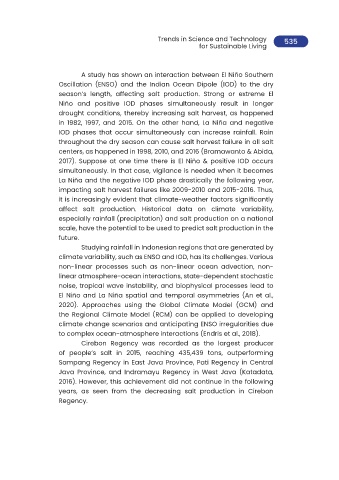Page 574 - Trends in Science and Technology fo Sustainable Living
P. 574
Trends in Science and Technology 535
for Sustainable Living
A study has shown an interaction between El Niño Southern
Oscillation (ENSO) and the Indian Ocean Dipole (IOD) to the dry
season’s length, affecting salt production. Strong or extreme El
Niño and positive IOD phases simultaneously result in longer
drought conditions, thereby increasing salt harvest, as happened
in 1982, 1997, and 2015. On the other hand, La Niña and negative
IOD phases that occur simultaneously can increase rainfall. Rain
throughout the dry season can cause salt harvest failure in all salt
centers, as happened in 1998, 2010, and 2016 (Bramawanto & Abida,
2017). Suppose at one time there is El Niño & positive IOD occurs
simultaneously. In that case, vigilance is needed when it becomes
La Niña and the negative IOD phase drastically the following year,
impacting salt harvest failures like 2009-2010 and 2015-2016. Thus,
it is increasingly evident that climate-weather factors significantly
affect salt production. Historical data on climate variability,
especially rainfall (precipitation) and salt production on a national
scale, have the potential to be used to predict salt production in the
future.
Studying rainfall in Indonesian regions that are generated by
climate variability, such as ENSO and IOD, has its challenges. Various
non-linear processes such as non-linear ocean advection, non-
linear atmosphere-ocean interactions, state-dependent stochastic
noise, tropical wave instability, and biophysical processes lead to
El Niño and La Niña spatial and temporal asymmetries (An et al.,
2020). Approaches using the Global Climate Model (GCM) and
the Regional Climate Model (RCM) can be applied to developing
climate change scenarios and anticipating ENSO irregularities due
to complex ocean-atmosphere interactions (Endris et al., 2018).
Cirebon Regency was recorded as the largest producer
of people’s salt in 2015, reaching 435,439 tons, outperforming
Sampang Regency in East Java Province, Pati Regency in Central
Java Province, and Indramayu Regency in West Java (Katadata,
2016). However, this achievement did not continue in the following
years, as seen from the decreasing salt production in Cirebon
Regency.

